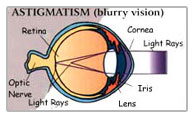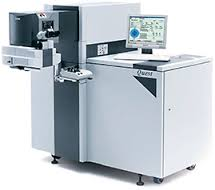What is refractive error?
 The function of the eye is to see clearly the objects around us. The inability of the eye to accurately focus the rays of light coming from distance on the retina is called refractive error. This condition may be either because the eye is too short or long in length, or because the cornea or lens does not have the required refractive power. There are three types of refractive errors:
The function of the eye is to see clearly the objects around us. The inability of the eye to accurately focus the rays of light coming from distance on the retina is called refractive error. This condition may be either because the eye is too short or long in length, or because the cornea or lens does not have the required refractive power. There are three types of refractive errors:
Myopia (near-sight):
this is the condition in which the eye is too long and the light is focused in front of the retina. Distant objects are blurred but the near objects are seen clearly. The eye has too much optical power and to correct it the optical power is reduced by either minus glasses or contact lenses, or by surgery.
Hypermetropia (long-sight):
this is the condition in which the eye is too short and the light is focused behind the retina. The eye has less optical power than is needed. When young the eye can use the lens within the eye to compensate, but reading glasses are needed at a relatively early age. Later, distance glasses (plus) are needed as well, such that glasses for distance and near are required.
Astigmatism:
this is the condition where the eye does not focus the light evenly, usually due to the cornea of the eye being more curved in one direction than the other. It may occur on its own or may be associated with myopia or hypermetropia.
What is Presbyopia?
Presbyopia is the normal aging process, where the lens progressively loses its capacity to increase its power for near vision (loss of accommodation). The distance vision may be normal, but the near vision becomes blurred with age greater than about 45 years. This is corrected by wearing reading glasses (plus) for the near work. This condition may occur in itself or may be present alongwith pre-existing myopia, hypermetropia or astigmatism.
What are the ways of treating refractive errors?
The refractive errors may be treated by either of the following ways:
- Changing the curvature of the cornea: this is the most popular mode of refractive surgery.
- Removing the natural lens and replacing it with an artificial lens of adequate power: it is similar to a routine phacoemulsification surgery, except that it is done in a clear lens and not a lens with cataract. As it is an invasive procedure and it also increases the chances of retinal detachment in eyes with high myopia, it is not recommended nowadays.
- Putting an additional artificial lens within the eye on top of the existing natural lens: this technique is still not very popular as it is also invasive and may increase the chances of cataract formation.
What are the ways of changing the curvature of cornea?
The commonly used methods for refractive surgery are:
- PhotoRefractive Keratotomy (PRK) : It is being used less commonly nowadays.
- Laser-Assisted In-Situ Keratomileusis (LASIK) :This is the most popular form of Laser treatment.
- LASEK (or Epi-LASIK) :This newer form of treatment may be suitable in some selected patients with very high power.
- ICLs or IpCLs : when there is large refractive error of morethan 10D these are the best choice
 What is Excimer laser?
What is Excimer laser?
Excimer laser is a far Ultra Violet (UV) light energy of wavelength 193 microns. It is invisible to human eye. This laser breaks the chemical bonds within the molecules (photoablation) with minimal thermal damage to the surrounding tissues. Thus it is very precise and can remodel the cornea with an accuracy of more than a thousandth of a millimeter.
How does Excimer laser correct the refractive error?
The effect of excimer laser on the cornea is very similar to grinding of a glass lens to change its refractive power. In eyes with refractive errors, excimer laser because of its high level of precision can change the shape of the cornea to change its refractive power to the desired state and thus correcting the refractive error. In myopia, the central part of the cornea is made flatter, and thus decreasing the refractive power of the cornea and of the eye, and thus correcting the refractive error. Similarly in hypermetropia, the laser removes a ring of tissue from the peripheral part of the cornea and thus makes the central part steeper and corrects the refractive error. As we know, in astigmatism, the cornea is more curved in one direction. Excimer laser can correct astigmatism also by selectively ablating the cornea in the required direction. We also have facilities for ICL, IPCL, CLE, RLE to remove spectacles.
